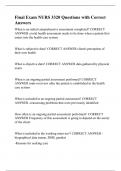Exam (elaborations)
Test Bank - Campbell Biology: Concepts and Connections, 10th Edition (Taylor), All 38 Chapters Covered > Download as a Pdf File <
Test Bank - Campbell Biology: Concepts and Connections, 10th Edition (Taylor), All 38 Chapters Covered > Download as a Pdf File < ******** INSTANT DOWNLOAD AS PDF FILE ******** Test Bank for Campbell Biology: Concepts & Connections, 10th Edition (Taylor), Chapter 1 - 38 > Download as a Pd...
[Show more]




